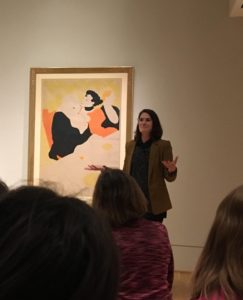19th Century Paris and Cristen Conger
By Daniela Sol

In celebration of Women’s History Month, the Phillips Collection, a gallery in downtown DC, held a gallery conversation last Thursday. Feminist activist, Cristen Conger, welcomed their new exhibit displaying Toulouse Lautrec’s vibrant portrayal of exuberant late 19th century Parisian art scenes. The conversation focused on topics related to female celebrities’ power and attraction of the public gaze in Lautrec’s art compared to female celebrities today portraying the same ideologies through social media.
Women ranging from all ages and corners of D.C. gathered to hear Conger welcome the idea of comparing the portrayal of female celebrities of Lautrec’s time to today’s portrayal of female celebrities in the media. The event produced delightful conversation as a variety of different perspectives bounced back and forth between the audience and Conger. Conger’s objective was to elaborate on the idea that feminist ideologies, which seem contemporary, are not as different as the ideas artists, such as Lautrec, focused in their art.
It was interesting to see how Conger compared starlets from the Moulin Rouge, like Jan Avril, with celebrities such as Kim Kardashian or Emma Watson.
Lautrec’s art confronts controversial ideas which liberate female stereotypes as he represents his muses in positions of power (while they’re performing) or positions of vulnerability (before putting their stage make up on). These “vulnerable positions”, as seen in some of his pieces, plus his grotesque interpretation of the performing starlets, that are supposed to represent beauty and desire, further emphasize Conger’s theory of Lautrec breaking stereotyped norms women were expected to fulfill.
She focused the conversation mainly around Lautrec’s take on women as objects of gaze and the comparison between the past and present. In Lautrec’s art, most of what’s depicted is the idea of women being objects of amusement. Conger emphasized how the themes present in his art can be seen in social media platforms, like Instagram, and how the relationship between women and spectator is based on this same theory of the “male gaze”. She raised the question: is there a difference between Lautrec’s paintings and screenplays and the selfies posted on Instagram today?
Conger made clever distinctions about how the male gaze, as present in Lautrec’s art, is still present in social media today but with key differences. One of them includes the presence of the female gaze on Instagram, not only in the audience, but also in the unique relationship between women “watching themselves being watched,” Conger said. This aspect compared to Lautrec, who had a “symbiotic artistic relationship” as Conrad said, with the performers and with himself creating his paintings.
Conrad explained how women in social media with this ability to “watch themselves” now have the potential to choose who gets to gaze upon them and what exactly can be gazed. This has created a whole different perspective of fame. Fame can now be attained by any person.
At the same time, “women have now become more aware of [their] sense of self in a public space,” Conrad said.
But what does this mean and have women actually become more aware of their identities in a public space? Is this a positive thing? Are stakes higher for women celebrities today? Has Kim Kardashian’s appropriation of her own sexuality by posting naked pictures of herself demeaned female empowerment or not? Has empowerment lost its meaning? Isn’t today’s definition of female empowerment that a woman should be able to do whatever they want and not be shamed by the public?
Questions like these were discussed between guests and Conrad as they were surrounded by Lautrec’s finest works. Answers were attempted and thoughts were left to ponder as 19th century Moulin Rouge posters where analyzed from a contemporary point of view.






